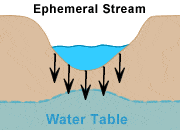
We need to continue to protect ephemeral streams and the role they provide in recharging our water supply until outdated methods used to develop land changes and respects natural processes.Īsk yourself this: If Mother Nature created ephemeral streams, isn’t there a reason why? Explore Now read: Affordable housing isn’t what you think it isĮric Sauer is a registered landscape architect. Until we as society place a high enough value on the water resources we need to survive and the ecosystem that ensures a sustainable future for that water, we must regulate critical parts of the ecosystem - including ephemeral streams - and impose a significant cost to offset destroying these critical “rivets.”ĭevelopment is needed and acceptable, but it is also critical to do so in a manner that protects natural systems at the same time. Development is possible that mimics the natural environment by getting water back in touch with the soil using techniques such as green roofs, permeable pavements and rain gardens that help keep the water cycle intact. Once development happens, this reverses, where nearly 80 percent or more runs off. When more areas are covered with impenetrable surfaces that don’t allow water to come into contact with soil, the results include flooding and the destruction of our streams, which were never intended to handle these frequent and longer peak flows produced by engineered stormwater systems.Ī healthy ecosystem such as a prairie or woodlot can absorb nearly 80 percent of all rainfall in a year. The health of our only water source relies on making sure that enough clean water does not run off but can get back into the aquifer so that we can ensure future generations have this critical resource to make the Miami Valley thrive.Īs we develop natural areas and farm fields with rooftops, driveways, parking lots and roads, we put the water that normally comes in contact with the soil or ephemeral streams into pipes and then directly into creeks or rivers, greatly reducing the opportunity for rain to complete the water cycle. The larger the body of water, the less soil surface comes in contact with the water and less can soak into the ground to refill the aquifer. These ephemeral streams eventually become creeks, then rivers and, in our case, the Gulf of Mexico. Intermittent streams may dry up for some period of. In healthy landscapes, ephemeral streams collect the first water runoff in a manner that regulates how fast water enters creeks and rivers, prevents erosion and gives the water another significant chance to be absorbed by the soil in the dry stream channel. Intermittent rivers and Ephemeral Streams (IRES) are river water bodies characterised by temporary flow. These streams are dry most of the time except after a rainfall. Ephemeral streams are a critical part of the recharge of the aquifer. This massive underground body of water provides us with our drinking water and supports our economy by providing the water supply that businesses need. Here in the Miami Valley, the water cycle includes water soaking into the ground and feeding the world’s largest accessible freshwater aquifer called the Buried Valley Aquifer. Ephemeral flow “…may occur simply because it is raining or has very recently rained or it has recently snowed and the snow has melted.In school, we learned about the water cycle.

Generally speaking, ephemeral flow is the result of precipitation. The last term that is not as tricky legally as intermittent is the definition of ephemeral flow.

The Trump administration’s EPA even discusses melting snow as a sole or primary source of intermittent flow. Ephemeral stream reaches were defined as lacking surface flow for the majority of the year, with a minimum threshold defined as having flow for fewer than. A SPA is an area upstream from a drinking water source or intake that contributes surface water flow to the drinking water intake during a 24-hour period. Intermittent generally means a seasonal situation when the groundwater table may be elevated. This analysis compared the stream length of intermittent, ephemeral, and headwater streams to total stream length within all mapped Source Protection Areas (SPAs) for each county. The issue is trickier when a new definition of Waters of the United States (WOTUS) is examined for perennial, intermittent, or ephemeral streams.Ī perennial stream is defined “…to mean surface water flowing continuously year-round.” An intermittent stream in the WOTUS rule means “…surface water flowing continuously during certain times of the year and more than in direct response to precipitation.” This term is very tricky and may mean you have jurisdiction by EPA and/or by the Corps of Engineers or you may not. More than half of the global river network is composed of intermittent rivers and ephemeral streams (IRES), which are expanding in response to climate. In an earlier blog, I discussed what is “not” a water of the United States.


 0 kommentar(er)
0 kommentar(er)
